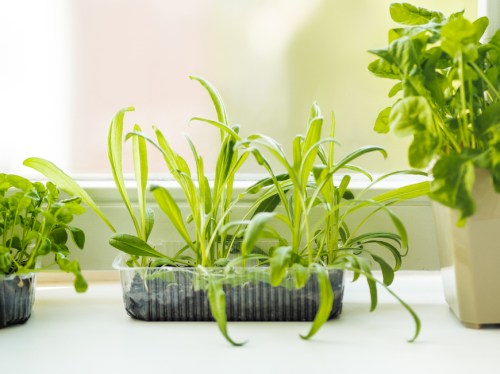There’s something so hopeful and pure about an indoor windowsill planter. You think to yourself, “I’m gonna do it, I’m going to be a gardener.” You dream of all the money you’ll save on groceries once you have an endless supply of parsley (yup, that’ll be the game-changer). Cut to two months later and you’re left with a series of wilting yellow-green sprigs or densely packed dirt that never sprouted.
Experts in This Article
horticulturist and resident plant mom at Bloomscape
In theory, it seems almost impossible to make any mistakes with an indoor windowsill planter. But whether you’re planting flowers, creating a miniature vegetable garden, or, yes, even growing herbs, a little mindfulness matters. So before you get to seeding, here are three things Joyce Mast, Bloomscape’s Plant Mom and resident plant expert, says to look out for.
The most common mistakes you’re making with your indoor windowsill planter
1. Placing the planter on the wrong windowsill
Let your compass be your guide here! And note that a north-facing window might not be the best move when it comes to setting up your rosemary, your sage, and your coriander.
“Windows with a northern exposure never receive bright, indirect sunlight,” says Mast. “It may be too low for some plants, yet many plants will thrive when placed very close to the window. Indoor herbs may not thrive when placed in a north-facing window as they need more light to grow.”
A window that faces south receives the most direct sunlight, which will be too bright for most indoor plants. If you need to spruce up the space with some greenery, save it for succulents and cacti, which can soak up all the sun it wants.
West and east are probably your best bets for plants that need a moderate amount of light. West windows get about four to six intense bright light per day, particular in the afternoon (morning light is usually in direct). If it seems too hot, Mast suggests moving the plant a couple of feet away from the window or hang sheers to cover the window.
“Most of the year, windows that face east provide bright indirect light for the better part of a day,” Mast says. “If it becomes too intense during the early spring before the leaves begin to appear, either move the plant a few feet from the window during that time of year.”
2. Assuming your plants are made for the windowsill in the first place
“For plants that don’t need so much sunlight, keep them farther away from the window so they’re not receiving direct light that will burn its foliage,” says Mast.
Basically, some plants that thrive in low to medium light can be scorched and start to burn in long, direct sunshine. If you see that happening, make sure the light isn’t too strong for your plants and start making some placement or lighting modifications.
“To fix this, find a medium to a bright indirectly lit area that will provide adequate light levels for long-term survival,” says Mast. “Or place a sheer over the window and move your plant about two to three feet’ back from the window to avoid the sun rays beating down on your plants’ leaves.”
3. Forgetting that windowsills receive different light intensities throughout the year
The light will change as the seasons change. For example, if the light was previously shaded by a maple tree in the summer and now it’s naked in the fall, the sun rays might be more intense.
“You may have to move your plant back a bit so the rays do not burn the foliage,” says Mast. “Also, check out the angle of the sun once the days become shorter and you may need to move some plants to adjust to the changing light levels in your home. ”
And if you’re brave enough to keep gardening through the winter, you’re going to need a keener eye and some serious weather protection. “Pay special attention to the foliage of your plants to make sure they are not getting any cold damage from touching the window panes and glass,” says Mast. “Also make sure the windows seal properly so the plants are not too drafty which can also cause leaf damage.”
These are the best plants for every room:
Oh hi! You look like someone who loves free workouts, discounts for cult-fave wellness brands, and exclusive Well+Good content. Sign up for Well+, our online community of wellness insiders, and unlock your rewards instantly.
Sign Up for Our Daily Newsletter
Get all the latest in wellness, trends, food, fitness, beauty, and more delivered right to your inbox.
Got it, you've been added to our email list.











